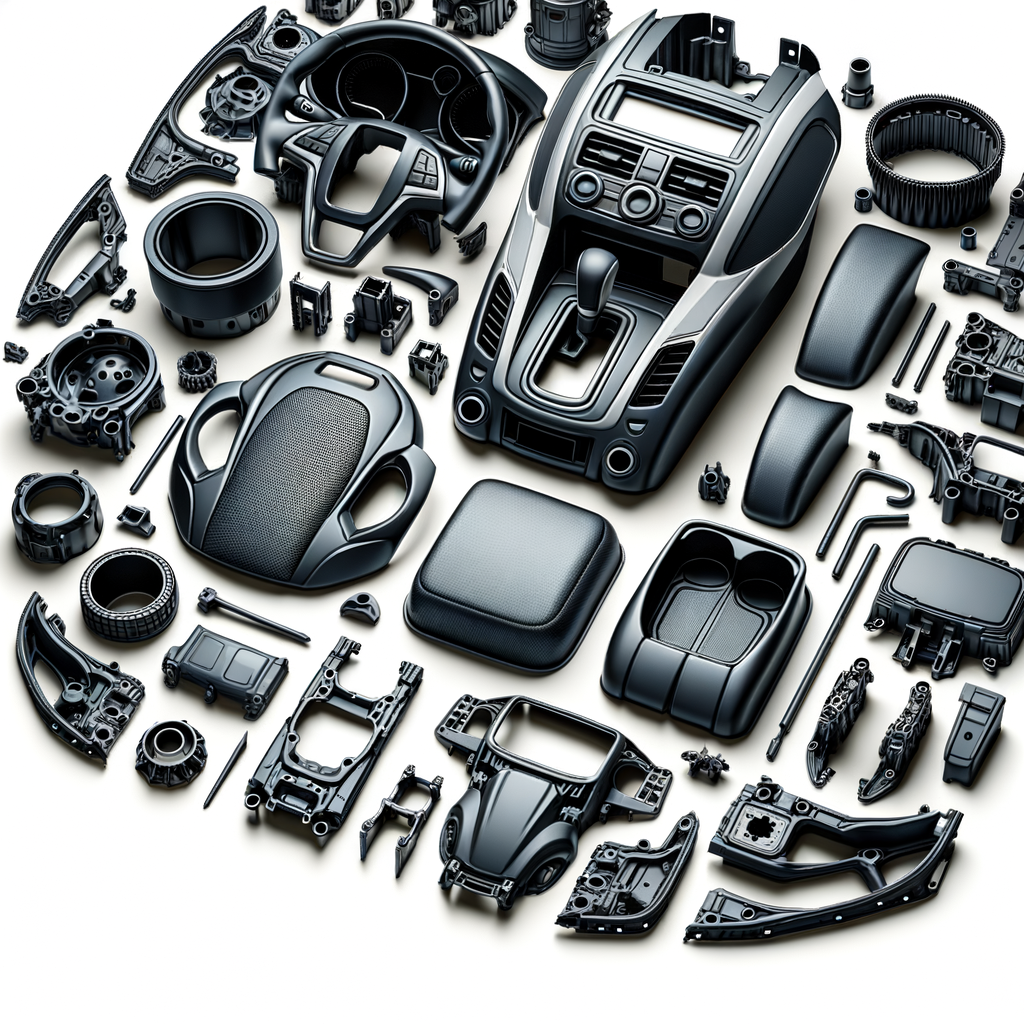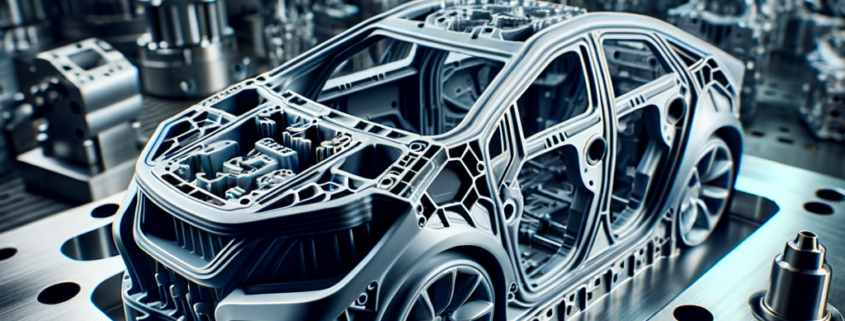Spuitgieten voor auto-onderdelen
Spuitgieten voor auto-onderdelen
INTRO
In de bruisende wereld van de autofabricage, waar efficiëntie en innovatie hand in hand gaan, is spuitgieten een revolutionair proces dat de essentie van ons dagelijks woon-werkverkeer vormt. Deze geavanceerde techniek is een hoeksteen geworden in de productie van auto-onderdelen, van de minuscule clips die je dashboard bij elkaar houden tot de robuuste bumper die je auto beschermt. De enorme veelzijdigheid en precisie van spuitgieten hebben het mogelijk gemaakt om ingewikkelde ontwerpen en stevige structuren te maken die zowel kostenefficiënt als tijdbesparend zijn.
Stel je voor: een kolossale machine met een enkel doel - gesmolten materiaal in een mal spuiten, en voilà, er ontstaat een auto-onderdeel! Deze methode is niet alleen kosteneffectief, maar maakt ook massaproductie mogelijk zonder afbreuk te doen aan de kwaliteit. Terwijl de auto-industrie zich richt op duurzaamheid en technologische vooruitgang, versnelt spuitgieten deze doelen door de productie mogelijk te maken van lichtgewicht onderdelen die de brandstofefficiëntie verbeteren. En dan hebben we het nog niet eens over de aanzienlijke vermindering van afval, waardoor het een lievelingetje is in de ogen van milieuactivisten.
In dit artikel maken we een joyride door het fascinerende landschap van spuitgieten voor auto-onderdelen. We onderzoeken hoe deze methode het "stuurwiel van fortuin" is geworden voor fabrikanten en verdiepen ons in de transformatie van onderdelen "van bumper tot bumper". We onderzoeken trends in de industrie, technologische vooruitgang en de gevolgen voor het milieu van de toepassing van dit wonderlijke productieproces. Dus, riemen vast en laten we beginnen aan deze reis om te ontdekken hoe spuitgieten de weg voor auto-onderdelen bepaalt.

Spuitgieten: Rad van fortuin
Spuitgieten kan worden beschouwd als het "stuurwiel van fortuin" voor de autowereld, dat fabrikanten naar succes en innovatie leidt. Bij dit proces worden plastic of andere materialen gesmolten en in vooraf ontworpen mallen gespoten om verschillende onderdelen te maken. Het stuurwiel zelf, een fundamenteel onderdeel van elk voertuig, is een perfect voorbeeld van het potentieel van deze methode. Door spuitgieten te gebruiken, kunnen fabrikanten ergonomische, duurzame en esthetisch mooie stuurwielen maken. Deze eigenschappen worden bereikt door verschillende materialen, zoals thermoplasten en polymeren, in het spuitgietproces te verwerken, waardoor een betere aanpassing en integratie van functies zoals airbags en bedieningsknoppen mogelijk wordt.
Het succes van spuitgieten bij de productie van stuurwielen kan worden toegeschreven aan de precisie en efficiëntie. Met de mogelijkheid om complexe vormen met nauwe toleranties te produceren, zorgt dit proces ervoor dat elk stuurwiel voldoet aan de hoge normen die vereist zijn voor veiligheid en prestaties. Fabrikanten kunnen ontwerpen en materialen snel aanpassen aan autotrends en de eisen van de consument, waardoor het stuurwiel een canvas voor innovatie wordt. Het spuitgieten vergemakkelijkt bijvoorbeeld de integratie van slimme technologie en sensoren in stuurwielen, waardoor functies als adaptieve cruisecontrol en rijbaanassistentie naadloos kunnen worden geïntegreerd.
Bovendien reiken de economische voordelen van spuitgieten verder dan het productieproces zelf. Door de productietijd te verkorten en materiaalafval te minimaliseren, kunnen bedrijven hun kosten aanzienlijk verlagen. Bovendien draagt het lichte gewicht van spuitgegoten onderdelen bij aan de algehele gewichtsvermindering van voertuigen, waardoor het brandstofverbruik toeneemt en de uitstoot afneemt. Dit sluit aan bij de verschuiving van de auto-industrie in de richting van duurzaamheid, omdat fabrikanten milieuvriendelijke voertuigen willen ontwikkelen zonder afbreuk te doen aan prestaties of veiligheid. In wezen is spuitgieten een centraal instrument geworden in de zoektocht van de auto-industrie naar een groenere, slimmere en efficiëntere toekomst.
Van bumper tot bumper: Vorm uw rit
Van de voorbumper tot de achterbumper speelt spuitgieten een cruciale rol bij het vormgeven van elk segment van een voertuig. Bumpers, die essentieel zijn voor het absorberen van schokken en het beschermen van de voertuigstructuur, zijn uitstekende voorbeelden van de voordelen van spuitgieten. Dit proces maakt de productie mogelijk van bumpers die niet alleen licht en flexibel zijn, maar ook bestand tegen grote krachten. Door gebruik te maken van zeer sterke materialen zoals polypropyleen en polycarbonaat kunnen fabrikanten bumpers maken die zowel de veiligheid als de esthetiek verbeteren, waardoor auto's er strak en modern uitzien.
De veelzijdigheid van spuitgieten strekt zich uit tot verschillende andere auto-onderdelen, wat bijdraagt tot het uitgebreide spuitgieten van een voertuig. Onderdelen zoals dashboards, deurpanelen en zelfs de ingewikkelde roosters die de persoonlijkheid van een auto bepalen, zijn producten van dit productiewonder. Door de naadloze integratie van functies zoals ventilatieopeningen, bekerhouders en elektronische displays, verandert spuitgieten deze onderdelen in multifunctionele elementen die de rijervaring verbeteren. De precisie en herhaalbaarheid van het proces zorgen ervoor dat elk onderdeel voldoet aan de strenge kwaliteitsnormen die nodig zijn voor toepassingen in de auto-industrie.
Technologische vooruitgang heeft de mogelijkheden van spuitgieten in de auto-industrie verder vergroot. De introductie van technieken zoals gasondersteund en multimateriaal spuitgieten heeft de ontwerpmogelijkheden voor auto-onderdelen uitgebreid. Dankzij deze innovaties kunnen onderdelen met verschillende diktes, texturen en kleuren worden gemaakt, waardoor fabrikanten de flexibiliteit hebben om aan verschillende consumentenvoorkeuren te voldoen. Daardoor is spuitgieten een onmisbaar hulpmiddel geworden bij het maken van voertuigen die niet alleen functioneel zijn, maar ook visueel aantrekkelijk, met de perfecte mix van vorm en functie.
OUTRO
Aan het einde van onze reis door de wereld van spuitgieten voor auto-onderdelen is het duidelijk dat dit proces niet zomaar een productiemethode is, maar een drijvende kracht achter innovatie en duurzaamheid in de auto-industrie. Spuitgieten heeft met zijn precisie, efficiëntie en aanpassingsvermogen een revolutie teweeggebracht in de productie van auto-onderdelen, van het cruciale stuurwiel tot de beschermende bumper. Door lichtgewicht, duurzame en aanpasbare onderdelen te kunnen maken, draagt dit proces bij aan de ontwikkeling van voertuigen die niet alleen veiliger en efficiënter, maar ook milieuvriendelijker zijn.
De toekomst van spuitgieten in de auto-industrie ziet er veelbelovend uit, met voortdurende verbeteringen in technologie en materialen die de weg vrijmaken voor nog meer mogelijkheden. Terwijl fabrikanten ernaar streven om te voldoen aan de eisen van een snel evoluerende markt, zal de rol van spuitgieten in de productie van hoogwaardige, innovatieve auto-onderdelen alleen maar blijven groeien. Van de integratie van slimme technologie in auto-onderdelen tot het verkleinen van de ecologische voetafdruk van autofabricage: spuitgieten zal de industrie naar een duurzamere en technologisch geavanceerdere toekomst leiden.
Kortom, spuitgieten is van onschatbare waarde gebleken in de autowereld en biedt fabrikanten de middelen om hun visie op de perfecte auto te realiseren. Voor de toekomst is het essentieel dat spelers in de sector deze technologie omarmen en het potentieel ervan verkennen om een efficiënter, duurzamer en opwindender autolandschap te creëren. Dus of je nu een fabrikant, ontwerper of autoliefhebber bent, de wereld van het spuitgieten biedt een schat aan mogelijkheden om te verkennen en te innoveren, om de toekomst vorm te geven van wat ons van de ene plaats naar de andere brengt.




Plaats een Reactie
Meepraten?Draag gerust bij!